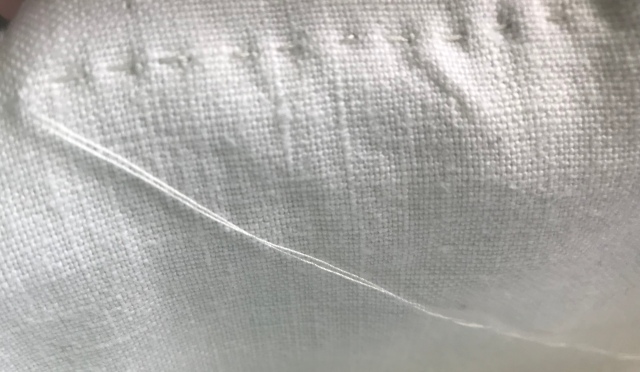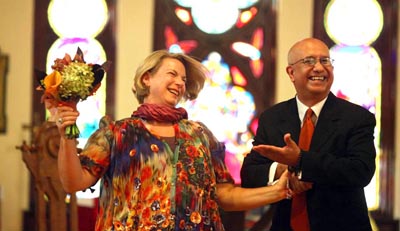
We moved this Vlaminck litho, bought at auction two years ago, from bedroom to livingroom
By Caitlin Kelly
Grateful for eight days completely out of the apartment — where we both also work as freelancers, my husband as a photo editor and I as a writer and writing coach.
We save a lot of money not renting office space or a co-working desk, (and can write off a small part of our monthly living costs as a result as a tax deduction), but that also means we’re using every part of our one bedroom all the time: one bathroom, one kitchen, every hallway, etc.
But it means additional wear and tear, even for two tidy adults with no pets or children.
So while we were away on holiday we had the following jobs professionally done:
— had the entrance hallway, wooden floor, re-sanded and refinished
— had the flaking, peeling bedroom window frame smoothed and repainted
— had all kitchen cabinets given a fresh coat of paint (installed 2013.)
That was, certainly, a big investment of $3,000.
When we got home and took another week off to settle in, we got to work:
— moving art from one room to another; we have a good collection of photos, by us, by friends and colleagues and prints, drawings and posters. Sometimes we put them away for a few years to appreciate them anew. We also rotate out intense/dark colors during the hot summer months.
— painted one wall a deep olive green
— moved three mirrors into the dark foyer. All are vintage/antique, none costing more than $300.
— ordered a new chandelier for our dining room and found an electrician ready to install it.

I found that funky old beveled mirror for $125 in an antique shop in Port Hope, Ontario
— added a patterned fabric, (home-sewn by hand, double width), cover for Jose’s homemade computer desk and moved a different lamp into its corner.
— arranged for pick-up by our local thrift shop for a number of items, including a standing lamp and balcony chair.
I’m more obsessed with beauty and good design than many people.
But I’m fine with it.
I studied interior design and learned a lot. And having lived (!?) 30 years in the same space means I’ve made multiple changes over time — wall colors, curtains, art, rugs — to not go mad with boredom and claustrophobia.
We’re not buying all-stuff-all-the-time! I often carry a tape measure with me to make sure anything we acquire will fit into our space, both spatially and visually.
Once you’ve established a color scheme, stick to it!
We use a great tribal wool rug I bought in Toronto decades ago for $100, and a nice repro wooden Pembroke table I found in a local consignment shop and a Crate and Barrel sofa we might soon replace, even though we love it, as the arms are sagging and an upholsterer told us it would cost more to re-do them than buy anew…
I also know what I like and will wait a long time for it….like our black Tizio lamp I bought in my 20s for (!) maybe $500, a huge sum then as now. It’s elegant, efficient, classic and versatile.
To save money, we do most of our own interior painting. We’ve been given some tremendous/iconic images as well — like the famous black and white photo of JFK standing at the Oval Office windows; this one signed by its creator and given to Jose, his colleague at The New York Times.

Same hallway — top image is a rotogravure by Steichen. The lower image is mine, a stairwell shot in Paris. Wall color: Gervase Yellow (archived), Farrow & Ball.
Tips for a quick refresh:
— Whenever you paint a room, note the paint color, brand and date you purchased it. Colors get discontinued! Farrow & Ball archives some colors but will remix any of them for you on demand and quickly.
— Keep some paint handy for touch-ups. Don’t allow it to get too hot or cold as this degrades the product; we keep ours at the back of a hallway closet.
— Replace items as they wear, chip, fray or discolor. If impossible, wash/dry clean/dye or toss and go without. It’s depressing to live in dirt or chaos.
— Throw stuff out! Those of us lucky enough to even have too much stuff have too much stuff!
— Sell whatever you can. I found out a vintage tribal rug I paid $200 for might fetch me $1,200 after I showed it to a local dealer. Next step, hope to sell it on Ebay or Chairish.
— Clean every corner, deeply. I had to scrub one wooden floor with a Brillo pad to remove grime that mopping didn’t address. Baseboards, the back of things (fridge, stove, printer, etc.) All windows!

Old Crate & Barrel cabinet, glass lined with fabric by the yard. Above, a photo of Jose and his parents, long gone, and a Moroccan lantern found at a flea market, sand-blasted at the auto body shop and painted in Blazer (Farrow & Ball, archived.) I hand-carried that huge wicker suitcase home from a Canadian antique show — thanks, Air Canada!
It always feels good to re-fresh our home — it nurtures, protects and revives us.

























